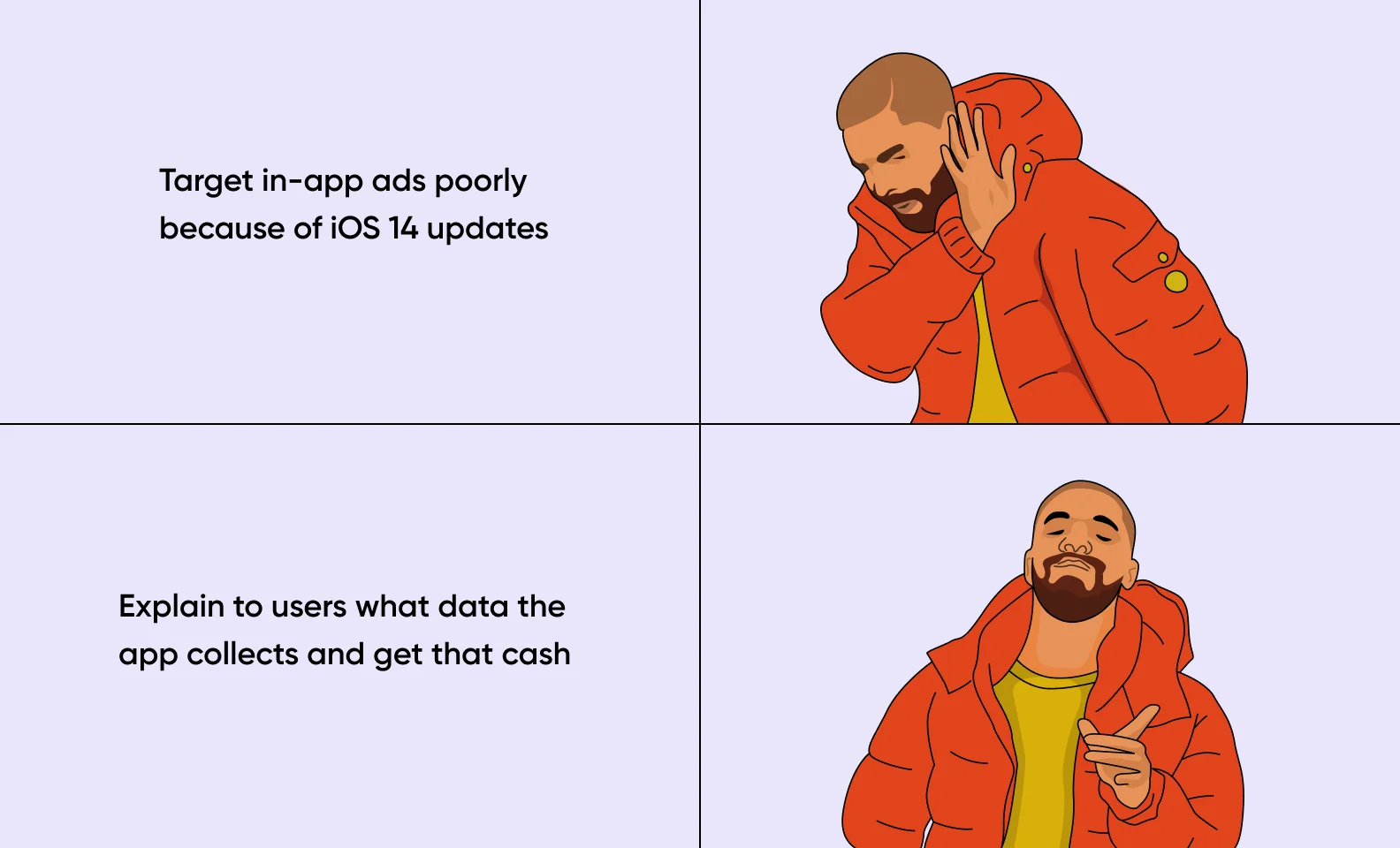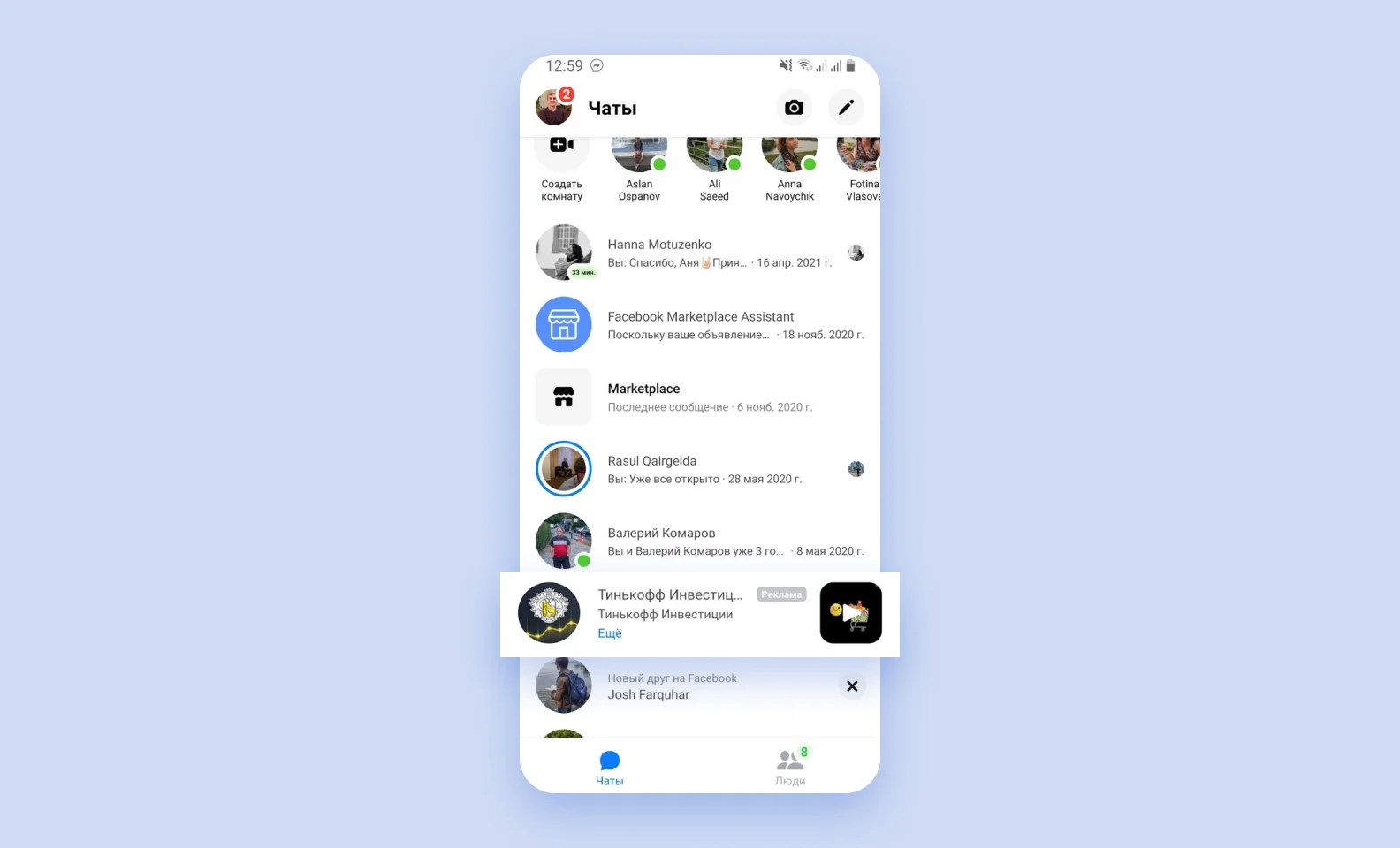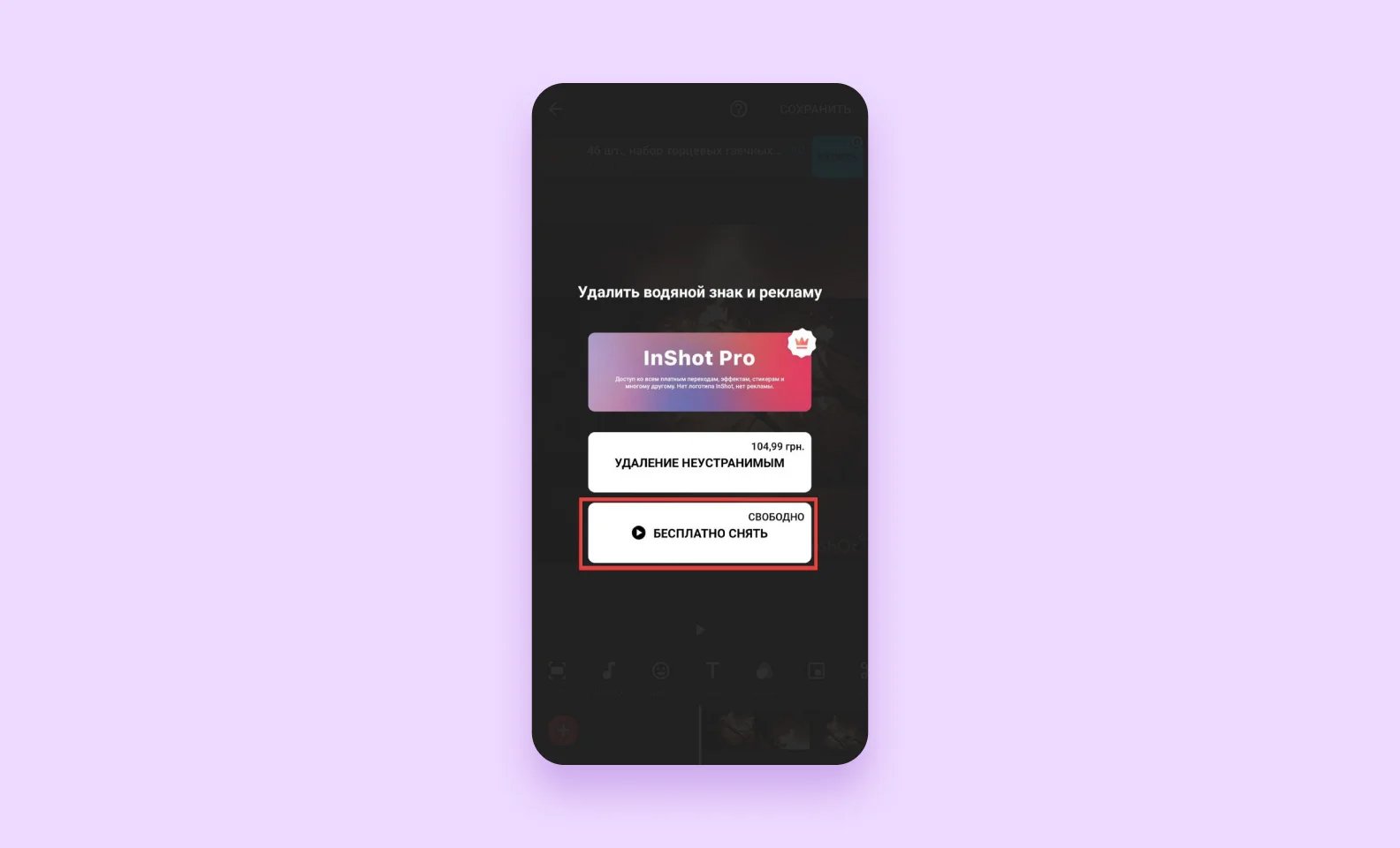


How to make money from a free app? To make up for mobile app development expenses, you need monetization. One of the options is in-app advertisements. Let’s look at the examples of ad types and consider how to choose the right one that won’t put off app users.

Lately, more and more people have switched to smartphones from PCs. Smartphones are more convenient: always on hand, cheaper, and the mobile Internet speed is comparable to wireline service or Wi-Fi. Following users, advertisers are switching to smartphones too. There, one can place an ad in both a browser and an app. The first option is the same in mobile and desktop versions, but the second one exists exclusively on smartphones. Let’s straighten it out: how can you use app advertisements?
In-app advertising refers to the ads the audience sees while using a mobile application. Mostly, they come as banners, videos, and clickable games integrated into the product.

To display paid promotions, advertisers buy space within the product from app publishers. The two parties are connected through a mobile ad network, which is a platform for buying spots for promotions. Ad networks use algorithms to show the most engaging videos and banners to the user.
In-app ads enhance the chances of user engagement, as they help reach out to a more relevant audience. The point is that ad networks offer better options for targeted campaigns compared to other similar tools.
Ad placement is one of the ways to make up for custom app development services and get some profit. If your free app is becoming popular among users, all you need is to enable ads and make money on views. As a result, it is a win-win for everyone:
Statistics show that smartphone owners spend about 3.5 hours on their phones every day. The trend is unlikely to change, and the mobile apps’ popularity will grow more in the future. Today, in-app advertising is an opportunity for efficient targeting. It stands out for flexible settings and high efficiency due to the fact that users don’t usually share smartphones with their family or colleagues as they do with personal computers. Thus, an app advertising campaign will always get a higher return rate than a browser ad.
To place an in-app advertisement, you need an ads network. It’s a kind of bridge between a publisher and an advertiser. An ads network allows a brand to attract its target audience via App Store or Play Store apps.
For app advertisements to a make profit, it’s essential to set them right. The key characteristics for ad targeting are a user’s gender, age, and geolocation. Besides, you can use the audience’s interests and behavior. For instance, an ads network can show a sports goods shop advertisement in a fitness app. In most cases, this user data is collected by apps, social networks, and search engines by default. However, lately, people tend to show concern about details that corporations may know about them and thus bother about keeping their personal data private.
With iOS 14, Apple released an updated privacy policy. It allows users to choose whether to provide the app with their data or not when they download it. The app would get consent for collecting and processing personal data by default in the previous iOS versions.
The mentioned changes in Apple’s privacy policy prove a trend for a conscious attitude toward using private data. This trend will make life tougher for app owners and advertisers but won’t collapse the whole in-app advertisements: it’s enough to explain to a user what data you collect and how you will use it.
Less data ➡️ weaker targeting setting ➡️ an add misses the Target Group

There are several app advertisement types. We will consider the ones that are popular with advertisers and thus guarantee a maximum profit for publishers.
One of the simplest in-app advertisement types. A banner is a block on top or the bottom of a screen. You can set a banner in a way to make them change from time to time.
Advertisers like banners for their low prices, so they often buy them. Thanks to an easy app integration process, banners work well for short-term advertisement campaigns. The key thing is to avoid an ad block overlaying the main content: it drives users mad.

A fixed position of banners makes the user remember where they can see an ad on their screen and start ignoring it. This effect is called ‘banner blindness’. To avoid a user ignoring ads, it’s better to seamlessly integrate them into the main app content as they do with the next ad type.
It is the most discreet type of app advertisement. Ad content seamlessly blends into an app fitting its design as much as possible. An advertisement looks like a part of the interface, so it’s considered the most informative one. Besides, it rarely frustrates users. A banner will look like just another item of sale in an online shop and pretend to be a regular post on a social network.
For instance, native ads are often integrated into messengers. In our example below, an ad looks like a chat.

Native ads integration requires more effort compared to placing traditional banners. It’s not enough to just insert an image into an app: you need to consider its interface and design. At the same time, native ads are thought to be a more efficient solution since it doesn’t jump out at users like regular banners and thus annoy them less.
It is a full-screen app advertisement that covers an app’s interface. It comes as static images, video clips, or animated content that pops up after a user finishes some activity, like completing a game level or switching between the screens.
For instance, a user finished editing a video in an app and wants to save a final clip. After hitting the ‘Save’ button on their smartphone screen, the user sees a video commercial that fully covers the app interface. Such a video lasts for 30 seconds (the countdown is shown in the left lower corner). If the user finds a promoted product interesting, they can click the ‘Go’ button in the lower right corner.

Depending on settings, a user can interact with interstitial ads in the following ways:
Such ads allow for placing more product information compared to banners or native ads. It also gives more space for creative ideas: unlike the previous ad types, limited by text and graphical formats, interstitials can come as videos or animations. Another advantage is that it’s hard to ignore such an ad, so a message will definitely reach the target user. Still, despite these advantages, interstitials are one of the most high-pressure mobile app advertisement types. Users don’t know when to expect the next clip to pop up and can’t ignore it like they can with native or banner ads.
Another full-screen video advertisement option. In this case, a user gets a reward for watching an ad. This ad type is mainly widespread in the gaming industry, where players are offered to watch a video in return for in-game currency.
For example, a Dragon Hills player can resurrect their dragon by watching a 30-second ad video. When the next high score is on the line, a player will be just happy to get such an opportunity.
Dragon Hills offers a player to resurrect a dragon for watching an ad
While people try to mask off ads in regular apps so as not to annoy a user, they place them in the foreground in mobile games and back them with in-game currency, extra hit points, or other bonuses. The method works out: players don’t only willingly watch another video but even get disappointed if it’s not there. What is more, people are ready to watch an ad once more to get a reward.
The key feature of Rewarded Video ads is that a user switches on a video clip themselves. Thus, they must know in advance that they will get a reward.
The Rewarded Video concept doesn’t work exclusively for games; it can be applied to any other app. However, a developer must choose the right award so that a user doesn’t get annoyed with this mobile app advertisement type. For example, the InShot app offers to watch an ad video to remove a watermark in the right corner of a clip.
For that, a user needs to do the following:
1. Click the watermark.

2. Click the ‘Free Remove’ button.

Besides, Rewarded Videos can also give access to exclusive content in non-gaming apps. This type of app advertisement works with free and paid versions of the apps. For instance, free users can read only three articles per month in a magazine app. When they open the fourth article, the app offers to subscribe to a paid plan or watch a video ad to unlock access to the extra article.
It is the most complex but the most elegant type of app advertisement: it allows users to interact with content. In this case, a user is offered to play a mini-game. This format came from the gaming industry but soon gained ground and was adopted by other verticals. For example, a playable ad on the Ruli.ru website allows a user to magnify various car parts with a lens. When you look at a car part through a magnifying lens, it triggers a pop-up window containing information about the technical condition, run, car owner’s number, and other essential parameters. Such an ad is a great way to attract someone planning to purchase a car.
Interactive advertising content ensures the audience’s attention
The major advantage of Playable Ads is that such app advertisements are unusual. Most users, sick and tired of aggressive pop-up windows, willingly involve themselves in simple gameplay. Besides, this type of app advertisement shines out for its high involvement level: a user is no longer a viewer but takes part in what is happening on a screen. What is more, Playable Ads are the best way to tell a user about a product: people can interact with content instead of waiting until another ad clip is over.
However, such commercials are pretty pricey: an advertiser will require custom app development services. Such mini-games are usually created from scratch which significantly boosts an ad campaign price.
Before starting any marketing campaign, advertisers pick the strategy for paying for traffic within an application. There are three main pricing models that app publishers usually offer for paid promotions.
Mille is a Latin word for “a thousand”. So, cost per mille refers to the price paid to showcase in-app ads 1000 times. CPM takes each viewer into account regardless of their clicks or reactions to banners. For app publishers, this is the safest path to take, as it guarantees ad revenue anyway. Though, the price for the placement is often low.
The next pricing model for in-app advertising is when publishers get money for every click on banners or videos. СPC drives better results in attracting a target audience, as just interested users do the click. This model remains well-liked among advertisers as it brings conversions, ad revenue, and brand awareness in one shot.
Unlike CPC, CPA counts not clicks but completed actions users take as they interact with the advertised product. Say, in-app ads promote some marketplace, and app publishers display banners on CPA terms. Then, advertisers generate ad revenue only if someone installs their app, signs up, or makes a purchase. Developers shoulder all the risks associated with user engagement, and as a result, this model is the most expensive.
There are several advantages of app advertisements over browser ads. We highlighted three major ones: a high click-through rate, better targeting, and ad blocker bypass. Let’s look at each in more detail.
According to various ad networks and marketing agencies, the click-through rate — the number of ad clicks to the number of views ratio — is higher for mobile ads, particularly for app advertisements. Such an advantage is the result of the other in-app advertisement features: accurate targeting and independence from ad blockers.
Unlike PCs, which can be shared by several people, smartphones are personal devices. People usually purchase a single PC for the whole family, and thus this PC is used by people of different ages with different interests and life goals. For instance, a teenage daughter, a housewife mother, and a father, who is an engineer, use a PC daily. Their retired grandfather visits them on weekends and also sits at the computer to read some fishing articles. It all negatively impacts targeting: it’s not clear who of the four family members is the key audience.
It works exactly the opposite with a smartphone. This device has only one owner and all the apps on this smartphone are tightly connected with the personal life and habits of this particular user.
Thanks to the first-person data, the app advertisements guarantee an accurate reach to the target audience. While setting an ad campaign, a marketer can use such parameters as gender, age, and geolocation.
Geolocation data gives the following advantages to an advertiser:
Many users install special extensions blocking ads in browsers — for instance, Adblock. If an advertisement is integrated into a mobile app, such a blocker will be ineffective. Thus, a user will see an ad anyway, no matter if they want it or not.
Usually, the only way to remove ad videos is to purchase a paid app version. However, not every app has such an option.
Whereas in-app advertising displays banners within some products, mobile advertising delivers them through the web browser. Customization capabilities and campaign performance differ correspondingly.
To sum up, both in-app and mobile advertising have proven effective in helping companies reach their business goals. You can launch app advertising and then top it off with web promotion to make the most out of mobile ad spending. Though the in-app option promises a more engaging dialogue with users, we recommend giving it a priority.
When product owners integrate in-app advertising, they should always keep in mind that, for the most part — people don’t like ads. Make sure to run promotional campaigns carefully so you don’t irritate your audience. Here are the best practices to consider.
When developers forget about UX and focus only on in-app advertising revenue, they lose their audience. To avoid it, observe the behavior of product users. This will help you adjust ad formats, frequency, and length of ads in a way that won’t ruin the user experience.
Always remember that in-app ads should enhance user experience, not spoil it.
This way, you can be sure that they reach out to specific user segments. Collect data about your product audience and group them based on age, gender, interests, and behavior patterns. Such insights allow developers to display in-app advertising that is most relevant to a specific user.
You can’t really predict if your audience likes interstitial ads or video ads more, but you can run some tests to figure it out. Say, use A/B testing to compare how users react to interstitial ads or banner ads. Integrating the formats people find convenient and enjoyable helps boost conversions and the overall performance of the marketing campaign.
User reaction to in-app advertising is also much influenced by its positioning within the app. Like someone mistaking banners for CTA buttons if they are placed too close to each other. You can experiment with ad placement using the above-mentioned A/B-testing approach. Such tests show which spots are the most effective for app advertising within the specific product.
Things like excessively long ads or dozens of banners within one screen overwhelm users. We recommend measuring out app advertising and integrating promotional materials carefully. Ads shouldn’t be an obstacle, so don’t make people work their way through numerous banners and videos. This will negatively impact the overall user experience of your product.
As you see, all the best practices are aimed at making the interaction with in-app ads equally effective for everyone. When users positively react to banners, advertisers meet business goals, and developers integrate ads hassle-free — consider the mission accomplished.
Let’s put it all together. Ads integration is a popular way to monetize apps. It helps attract the part of a target audience that doesn’t want to pay for downloading a program or subscription.
Here is what you need to remember when you integrate advertisements into your mobile app.
At Purrweb, we believe that the best monetization model is a subscription. Such an approach allows for keeping the app’s visual side neat and clean. Still, ads integration is also a good way to make money for a publisher.
Want to integrate ads into your app? <a class="blog-modal_opener">Contact us</a>, and we will help you with integration.